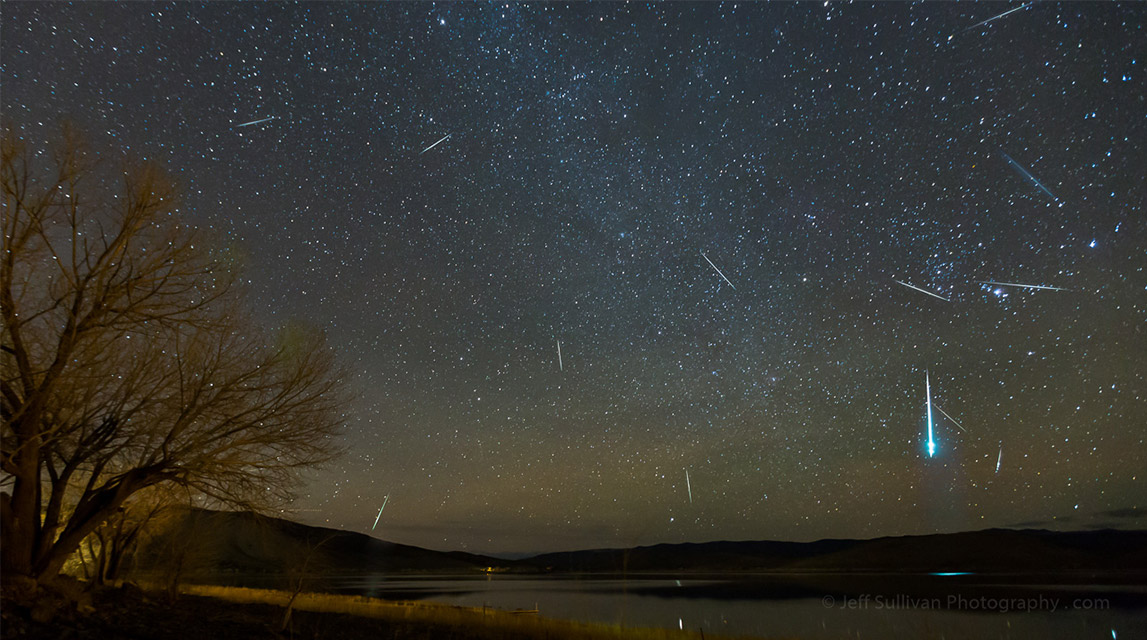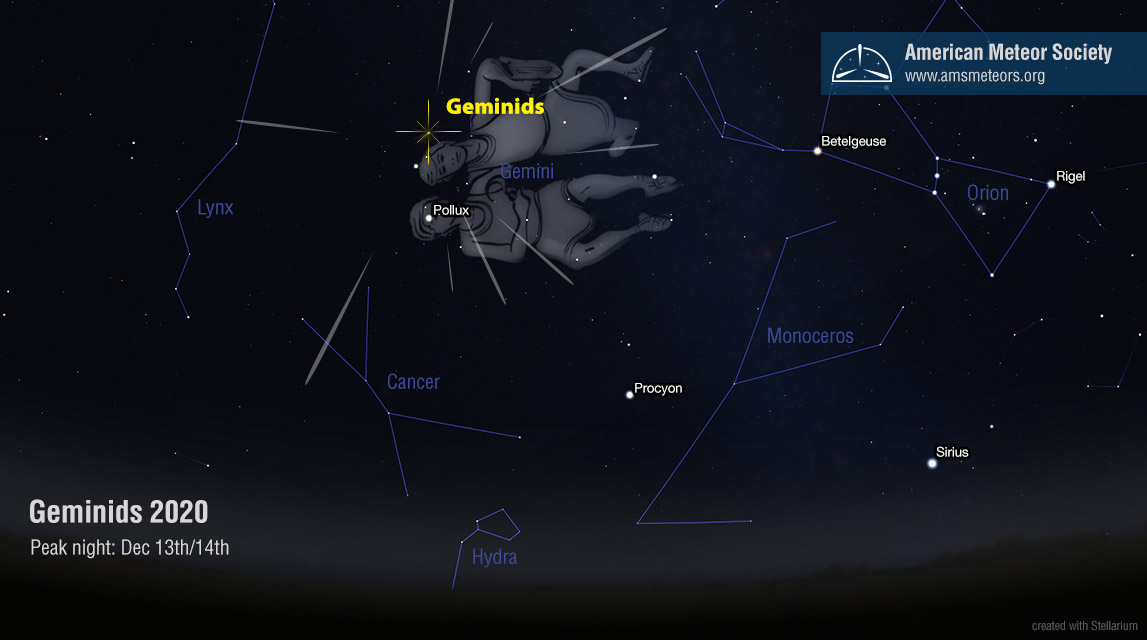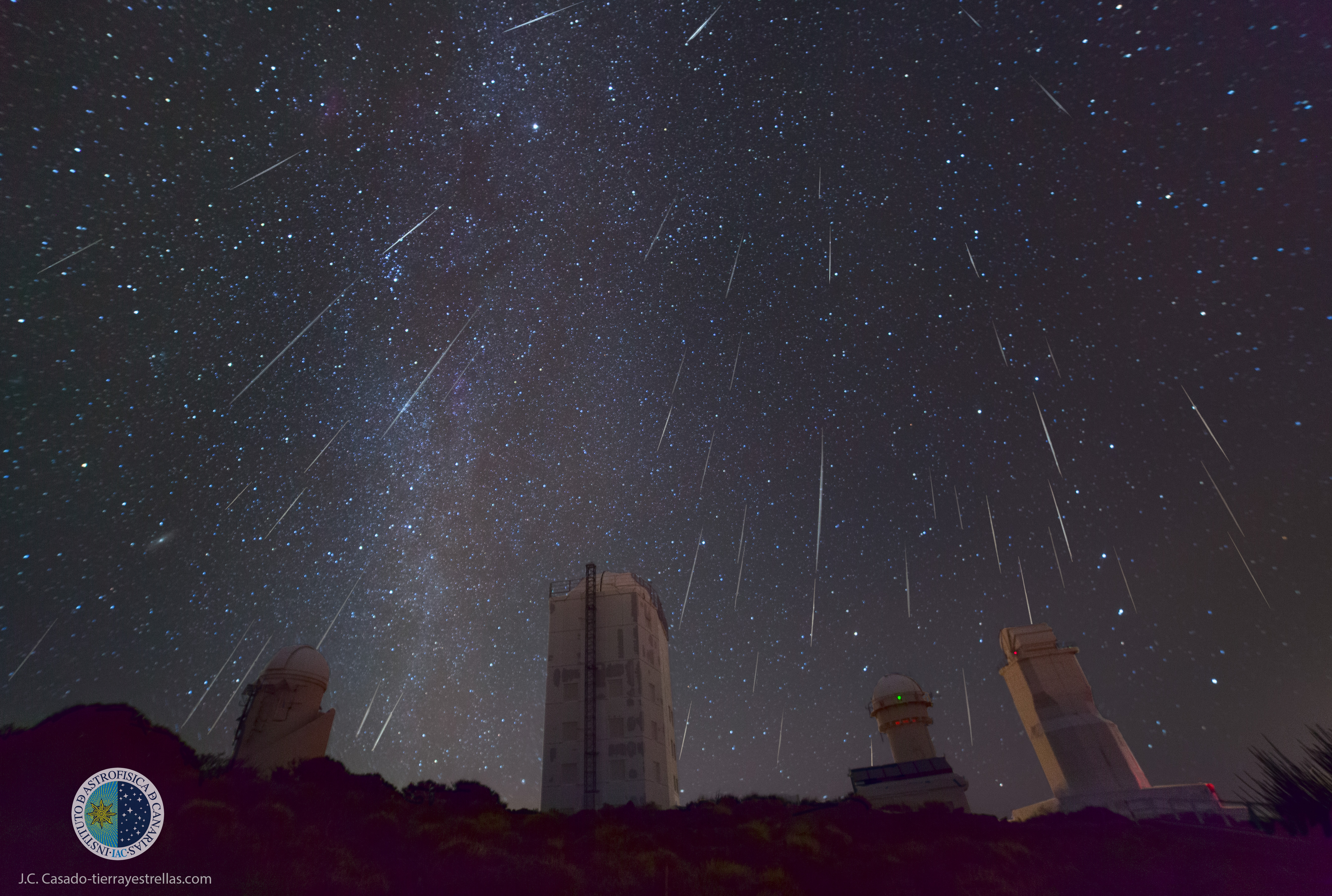
© Jeff Sullivan 2014
The most dependable meteor shower
Year in and year out the Geminids are currently the most dependable meteor shower. Unfortunately, they are active in December when temperatures are often cold and skies cloudy in the northern hemisphere. Then is this display worth viewing this year? Most certainly! So it may be chilly out, but if you bundle up and step outside over the next week, you’ll be able to enjoy one of the most active meteor showers of the year!
The Geminids are often bright and intensely colored. Due to their medium-slow velocity, persistent trains are not usually seen. These meteors are also seen in the southern hemisphere, but only during the middle of the night and at a reduced rate.
Unlike most other meteor showers, the Geminids are not associated with a comet but with an asteroid. 3200 Phaethon is an asteroid with an orbit that brings it closer to the Sun than any other named asteroid (though there are numerous unnamed asteroids with smaller perihelia*). For this reason, it was named after the Greek myth of Phaëthon, son of the sun god Helios.
Even though 3200 Phaethon is classified as an asteroid, it often acts like a comet by ejecting dust when it nears the sun. The Earth is near the orbit of 3200 Phaethon during the first three weeks of December. It comes closest to the core of the orbit on December 14th each year. This is the date most Geminid meteors are encountered and seen. When the Earth is near the edge of the orbital debris of the asteroid, little activity is seen.
* The perihelia is the point in a solar orbit where the orbiting body is closest to the sun.
So when and where do I look?
The Geminids are expected to be active between December 1st and 22nd this year. The highest rates are expected to occur on the night of December 13/14, when rates can exceed one per minute from dark sky sites. The early portion of the Geminid activity will be difficult to observe due to the waning gibbous moon. The moon will not reach its last quarter phase until December 7th. On that date the half-illuminated moon will lie above the horizon from midnight onward. One can still view Geminid activity during the evening hours but rates will be low due to the fact that the maximum is a week away and that the radiant lies low in the east during the early evening hours. During December 7-14, the moon will rise approximately 45 minutes later with each passing night. This will allow you to watch later in the night with each passing day. By December 12, the moon will be a non-factor as it will be a slender crescent and will not rise until the start of dawn. If your weather appears to be overcast on the peak night, the two nights prior and the one night after the peak will also produce impressive activity.

The prime hours to watch Geminid activity are between 11pm and 4am local standard time. During these hours the radiant of the Geminid meteors will lie highest above the horizon. The radiant lies in the constellation of Gemini near the bright star known as Castor (alpha Geminorum). The radiant is not the actual source of the meteors. This artificial point in the sky, as well as the stars of Gemini, happen to lie in the background while the stream of Geminid meteors enter the atmosphere, seemingly from the radiant in the constellation of Gemini. The radiant point and the constellation of Gemini serves as a useful guide to identifying Geminids as not all meteors seen in December are Geminids. There are several other minor showers radiating from the constellations of Orion, Monoceros, Hydra, and Leo Minor, to name a few. There are also random meteors that appear from all over the sky. These meteors once belonged to their own meteor shower, but time has dispersed them to the point that a connection with other meteors is now impossible. On the night of maximum activity, the Geminids will provide over 90 percent of the meteor activity during the night. As you move away from the peak night this percentage falls drastically.
Geminid meteors can appear in any part of the sky. You do not have to face the constellation of Gemini to see them. It does help to have the radiant somewhere within your field of view. This will help in the identification of each meteor. Geminid meteors will shoot outward from the radiant while others will have random paths and speeds. Geminid meteors will appear slowest and shortest near the radiant. This is due to foreshortening as the meteors seen close to the radiant are moving in a direction toward you. Geminid meteors will appear fastest and longest at a point 90 degrees away from the radiant. Beyond 90 degrees distant from the radiant, the meteors will begin to slow and become shorter again.
During the early evening hours, I like to face eastward and watch Geminid earthgrazers shoot from the northeastern horizon. When viewed at this time and position, the Geminid meteoroids (meteors still in outer space) can only graze the upper portions of the atmosphere. Due to the lower density of air molecules at this altitude, the meteors take longer to disintegrate and thus create long streaks in the sky. Most of these long streaks appear low in the north or south, but if you are lucky you will witness some that shoot high overhead.
As the night progresses, the Geminid radiant rises higher into the eastern sky. Their duration and length will become noticeably shorter as they can now penetrate deeper into the atmosphere. This should not cause concern as these meteors still disintegrate while still many miles high in the atmosphere. While the individual meteors may become less impressive, there will now be many more of them as you can now see the meteors that were once shooting downward, below the horizon. For the remainder of the night the Geminids will produce an occasional colorful fireball, which is a meteor brighter than all the objects in the sky except the sun and moon. You may think that fireballs are created by very large meteoroids. Actually, fireballs can be produced by object as small as golf balls. When you consider the average meteor is produced by meteoroids the size of small pebble, then a golf ball is large compared to them. Geminid fireballs are notable for their intense color. Many of these are brilliant green, as well as yellow and orange.
During the peak hours of the Geminid display I like to face due south and have the radiant drift westward through my field of view. This also allows me to monitor the minor showers that are active in the same region of the sky. If I have enough energy to view until dawn, I tend to shift my view more westward to keep the radiant within my field of view.
Don’t go outside and stand to try and view the Geminid activity. Your neck will quickly stiffen and you will soon tire. I suggest using a comfortable lounge chair that allows you to look half-way up in the sky comfortably. Bring plenty of blankets to keep warm. Those who wish to contribute meteor counts should watch for at least one hour. The reason for this is that meteoroids are distributed randomly in outer space. When quoted hourly rates are 60, this does not mean you will see one meteor every minute. There will be 5 to 10 minute periods when little activity is evident. There will also be periods of similar length when there will be continuous activity of 3-4 meteors per minute. There are several “peaks” and “valleys” of meteor activity each hour so if you only watch for a short time, you may find yourself viewing during one of the lulls of activity.

Canon EOS 5D Mark II, 50.0 mm, ISO 3200 – composite
Viewing meteor activity is a great way to easily contribute to science by being a citizen scientist. In order to produce scientifically useful data you need to view for at least one hour and provide shower associations with each meteor you witness. It also is necessary to provide us with the magnitude of the faintest star you can see. This is easily done by counting the number of stars visible with certain areas of the sky. Charts for these areas are available at: https://www.imo.net/observations/methods/visual-observation/major/observation/#table1. Chart #4 would be most helpful. Also helpful tips for visual observing are available at: https://www.imo.net/observations/methods/visual-observation/ and https://www.imo.net/observations/methods/visual-observation/major/observation/. In order to share your observations we suggest that you fill out a visual meteor report form provided by the International Meteor Organization. The AMS also accepts observations emailed directly to: lunro.imo.usa@gmail.com. We wish you good luck and look forward to seeing your viewing results!
 American Meteor Society
American Meteor Society
Hi Bob, I am in a rural area in Western Massachusetts. Am I correct that the best time to view on December 14th is between 11:00 pm and 4:00 am? I’m not a late owl but want to be sure to see as much of the showers as possible.
Lisa and All,
Yes, that is the right time for your area. Since you are not a night owl, I would suggest starting at 11pm (Sunday evening) and watch as long as you can. It should be kicking into high gear by then. Being in a rural area will really help you see more activity as a lot of these meteors are faint. Maybe you will even see a fireball or two! These are meteors that are brighter than everything in the sky but the sun and moon. Good luck!
Thank you for this extremely well written piece that explains the shower and viewing in the perfect amount of detail for me, an amateur astronomer. I’m also not a night owl, but will try napping during the day to see how long I can last.
Bob: It’s going to be mostly clear here in SoCal tonight (Friday). Sunday the weather looks more overcast (50-60% cloud cover). I only have one night to go – is tonght the better night? Not sure what the average rate per hour would be two days before peak.
Thanks! Chris
Chris and All,
Chris,
I would observe tonight and any other clear night through the 15th. Activity will be worth the drive. Let’s hope the sky cooperates!
What about viewing from Hawaii! Is it the same time where ever you are?
Tyler and All,
Yes, it’s basically the same time wherever you are. Those large countries with only one time zone or time a zone that stretches far more than 15 degrees longitude may be off by an hour or so.
When you say “evening” is best for seeing earth grazers… what time is that at night? Do the earth grazers begin before the 11 pm prime starts. Additionally, how common are earth grazers during this shower?
Anna and All,
Earthgrazers only occur when the source of the meteors lies close to the horizon. For the Geminids, this only occurs during the two hour period after it becomes totally dark. For most people located in the northern hemisphere this is roughly 5-7pm local standard time. Due to the strong activity, the Geminids offer the best opportunity of the year to view these long meteors, especially on the evening of December 13th. Yet these meteors are few as most of the activity at this time occurs below the horizon. Those meteors that are visible often travel in paths low along the northern and southern horizons. If you are lucky, you may see up to 5 per hour that travel upward and create long streaks high in the sky. These meteors are often dim so viewing from a dark area certainly improves their visibility.
How about idaho? It is barely dark by 7pm. Thankyou for the thoughtful post.
Ray and All,
I checked the sunset and twilight times for Boise and the sun sets at 4:42pm MST and it becomes completely dark by 6:33pm MST. Other locations in Idaho would not be that much different. I would start watching for earthgrazers at 6:30pm MST. Remember, at that time you will not see many, but the ones you see will be impressive. Activity increases as the night progresses.
Good luck!
Hello Bob: Thank you for this article. It is very helpful. I live in Princeton,NJ and am trying to decide if I can observe successfully from here or if I should make the effort to drive over to the beach (one hour away) in attempt to limit light interference. Your comments would be appreciated. Thank you.
Edward and All,
The more stars you can see, the more meteors you will see. If it is clear, you will see some from Princeton. If you wish to see more activity, then head for the beach.
Good Luck!
Here in NJ, it’s usually cloudy when a meteor shower peaks. such as it was this year as well!
Thank you for an easily understood explanation of how to watch the meteor showers. Hoping the clouds in SoCal don’t hinder our viewing experience.
hi all, i live in buffalo grove, illinois when is the best time for me to view showers thanks and happy holidays.
11pm-4am local time
I’m in New York can’t see anything here because of heavy clouds but it happens to me every time I want to see a meteor shower clouds build up and I miss it every time.
2020 Very poor showing in Florida. 2 meteors over two hours. Both bright but really not worth the effort. A lot of hype for next to nothing.
Thanks so much for this. I will be viewing from Louisiana! Will 11pm-4am be a good viewing time for central time zone?
Yes
I was just out walking my dog and saw a huge green and blue meteor. I had no idea about the shower happening until I read this article! So cool! Thank you!
I’ve missed the peak night ….my question …is tonight really even worthy to venture out for being the last estimated night? I live in Portland Oregon can get to a remote area quite quickly as well.
Cheli and All,
Probably not as rates would be very low. If your skies are clear you can try again on Monday evening as the Ursids will peak that night. The best time will be 10pm until dawn.
Good luck!